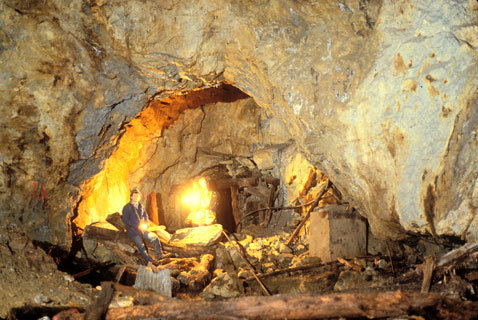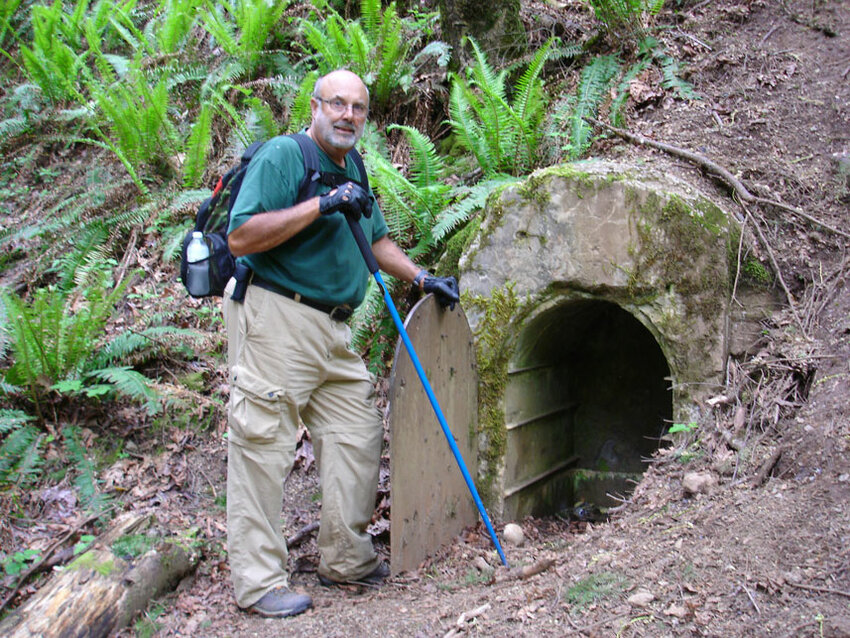 Nooksack Mine Stone Safe
Nooksack Mine Stone SafeEditor's note: This is an excerpt from volume two of Impero’s “Towns of the North Fork of the Nooksack River,” available for purchase at Graham’s Store in Glacier, Village Books in Bellingham and Lynden, Crossroads Grocery in Maple Falls, the Whatcom Museum, the Lynden Museum and online.
Jack Post of Sumas discovered gold on Bear Mountain in the North Cascades on August 23, 1897. There had been many previous claims filed in this area, but this was the first one that proved to be of real value.
 Miner with Air Drill
Miner with Air DrillWhen this discovery was made public, the influx of men heading into the North Cascades in search of gold was unbelievable. A disadvantage of the late August discovery was that it was quite late in the season, and so the real gold rush would begin in 1898. A mining district was organized in the area and identified as the Mount Baker Mining District. The reason for the organization of these mining districts was that by doing so they could then somewhat govern themselves; and in some cases, they were so far removed from the Whatcom County Sheriff’s Office that this provided that the law be upheld.
Within the next year the gold rush town named Shuksan was created at the intersection of Swamp/Ruth Creeks and the Nooksack River. This little town grew quite rapidly, although no one having the knowledge on how to build structures that could resist the tremendous snowfall that they would receive became one of the biggest problems.
I believe within the next 10 years there had been over 6,000 mining claims filed in this area. There were only two which really proved to be of value: the first being the Lone Jack and the second one being the Boundary Red.
What follows are descriptions of four of the mines that turned out to be failures.
It was midsummer, and the Gargett family picnic/reunion was being held at the Gargett farm. Three generations of family were present as was normal and when the feast was complete, the discussion turned to family history.
 Roy Gargett with Promising Sample
Roy Gargett with Promising SampleAs usual the subject of the Gargett Mine came up as it almost always did, and the tales started to fly. The members noticed that Roy Gargett, the senior family member and driving force of the Gargett Mine, had tears in his eyes. Slowly, he stood, excused himself, and walked out into the field alone with his thoughts.
The third-generation family members continued to talk about all the years and money that was spent on the gold mine that did not produce one cent of return. They mentioned that Roy was saddened about the bad decisions that have been made concerning the mine.
After listening for a period of time, Marie Christy, daughter of Roy, cut into the discussion. “First, my dad is not upset by bad decisions or bitter over anything or his life at the mine. Dad has repeatedly stated that those years and all the effort at the mine were the best times of his life. To be in a beautiful alpine country and to wake each day to the magnitude of nature was unbelievable, and he would not have traded it for any other type of life. He is not bitter, but sad because his body could not make the hike; and he knew that if he were to tunnel another 50 feet, he was sure that he would hit the vein.”
In 1901, the Gargett family had become involved in the mine and that involvement continued for 43 years. For all those years Roy Gargett was the driving force of the operation. In the beginning others owned the mine, but over time the Gargett family became the sole owner of the original, plus additional claims.
 Exiting Mine with Ore Cart of Material
Exiting Mine with Ore Cart of MaterialThe operation was situated on the south side of Red Mountain, which later became known as Larrabee Mountain. It was one of the most inaccessible mines in the Mt. Baker Mining District.
The trip in and out from the town of Sumas where the Gargett family resided and operated the Gargett General Store was a major task. In the original days before the train, the trip involved horseback or horse and wagon to the Loop Ranch above Maple Falls, and from that point on it became either a walk or partial horseback ride. The early constructed trail went through Glacier to the small town of Shuksan, and then up the Lone Jack Trail and through Gold Run Pass, then down almost to Tomyhoi Lake, and then back up to the mine site.
In later years a new trail was constructed, this being the one from Twin Lakes to Low Pass, to High Pass, and down to the mine.
The location of the mine required that it start operating much earlier in the spring than any of the other mines in the area. The reason being that the water source to operate the equipment drained out of a large basin at the base of Red Mountain; and this water source would run out by midsummer, thus shutting down the operation. They would go in at such an early point that they had to do a tremendous amount of snow shoveling just to get into their building and to find their equipment.
For payment for working in the mine, a miner would receive stock certificates for ownership. However, when the depression was on, any young men around Sumas would go in to work and be very satisfied with getting three square meals a day.
Revenue from the Gargett Store was the main source of money used for the operation of the mine.
No mine’s location in the Mt. Baker Mining District compared to the beautiful setting of the Gargett.
The Excelsior Mine was located on the hillside above the confluence of the Nooksack River and Wells Creek. The location is almost across from Nooksack Falls to the south.
 Upper Elevation of the Excelsior Mine
Upper Elevation of the Excelsior MineThe Excelsior was somewhat different from the other mines that were successful in the Mt. Baker Mining District in that it was at a lower elevation and in dense timber. This mine could operate almost year-round without being affected by the winter. Today, an overgrown road that goes off the Dead Horse Road leads to the operation.
The mine went through many different ownerships, each trying a different method of recovering minerals from the ore that was of questionable value. As time went on with the new ownerships, the struggles became greater with environmental issues. The size of the proposed mining operation was going to be of major proportion and create a significant environmental scar. The legal battles continued until the spotted owl came into the picture. With owls in the region, the developers finally gave up, and no further development has been done or is planned at this time.
 Excelsior Big Stope
Excelsior Big StopeUp and down Ruth Creek to the summit of Hannegan Pass there were numerous reports of a grizzly, or silvertip, bear being seen.
 Silvertip Main Entry
Silvertip Main EntryJack Post and Lumen Van Valkenberg, the two prospectors made famous by their discovery of the Lone Jack Gold Mine, discovered gold in a creek coming off Goat Mountain on June 10, 1897.
The claims sat inactive for many years, but in 1937 Ray Block of Seattle rediscovered three of the original ones.
Work on developing the mine began in 1943 and took four years to complete. The most interesting fact in its development was the construction of a two-bucket cable tramway to a length of 2,600 feet and a difference in elevation from the mine portal to the mill of roughly 1,000 feet.
In the years 1943 and 1947 actual ore and concentrates with a low value were shipped to a smelter in Tacoma.
The winter of 1947/1948 brought down a major snowslide from high on the south face of Goat Mountain that totally destroyed the tramway and mill. Fortunately, it stopped short of Ray Block’s cabin.
Beginning on September 18, 1899, and continuing into 1900, a small group of men quietly staked eight claims, including water rights, on Lodge Creek, located on the west side of Sumas Mountain, east of the town of Nooksack.
 Digging out the Adit
Digging out the AditAs soon as these actions were made public, all sorts of questions arose. There had never been any gold discovered in this area, and secondly, they were miles from the Mt. Baker Mining District where the gold was being discovered.
C. F. Bernard and J. Swinehart were the recorded owners.
From the very beginning, all the activity up on the mountainside was kept relatively secret. The first thing that was constructed was a wagon road from the town of Nooksack to the mine site.
The normal process in a discovery is to first develop the mining portion of the work. This would include items such as following the gold vein into the mountain, extracting numerous samples to be assayed, and then from that point, depending on the riches, the rest of the facility would commence being developed.
At the Nooksack, however, everything was done in a reverse order. From the very beginning they started building a hotel, dance hall, several bunkhouses, and a large, framed office building, and then a very modern gold recovery facility.
The Nooksack Mining Company managed to operate this gold mine and resort for over two years. They were bringing in hundreds of potential investors, showing them the gold on the walls, and then also showing them a very good time.
The question of the riches of the Nooksack continued for years, and finally an old prospector from Sumas snuck up to the mine, worked his way past the security guard, and went into the adit. He took many samples; and then sneaking past the guard again, returned to Sumas where he had the samples assayed. The assay report came back with absolutely no gold to be found, and with that report, the total value of the mine was nothing. Its walls had been seeded by removing the shot from shotgun shells and replacing it with gold flakes, then firing them against the walls. This was done in many locations within the mine to attract the investors.
On February 17, 1906, the property of the Nooksack Mining Company was sold on the steps of the Whatcom County Courthouse to the highest bidder. The two original owners of the mine, Bernard and Swinehart, disappeared one night and were never heard from again.
The only consolation for the hundreds of investors was that these two-bit crooks were not ordinary swindlers, as all 370 stockholders did not receive a dime of any kind. X